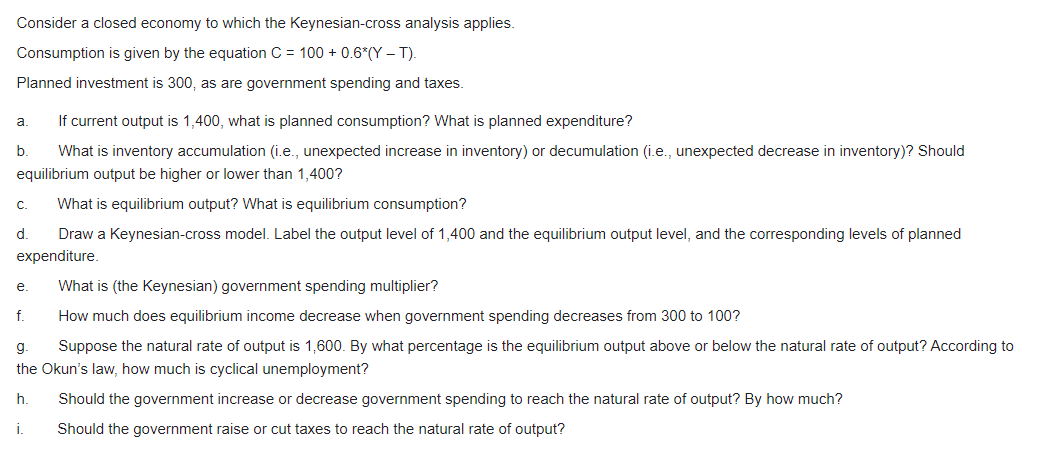Consider a closed economy to which the Keynesian-cross analysis applies. Consumption is given by the equation C = 100+ 0.6*(Y-T). Planned investment is 300, as are government spending and taxes. a. If current output is 1,400, what is planned consumption? What is planned expenditure? b. What is inventory accumulation (i.e., unexpected increase in inventory) or decumulation (i.e., unexpected decrease in inventory)? Should equilibrium output be higher or lower than 1,400? C. What is equilibrium output? What is equilibrium consumption? d. Draw a Keynesian-cross model. Label the output level of 1,400 and the equilibrium output level, and the corresponding levels of planned expenditure. e. What is (the Keynesian) government spending multiplier? f. How much does equilibrium income decrease when government spending decreases from 300 to 100? g. Suppose the natural rate of output is 1,600. By what percentage is the equilibrium output above or below the natural rate of output? According the Okun's law, how much is cyclical unemployment? h. Should the government increase or decrease government spending to reach the natural rate of output? By how much? i. Should the government raise or cut taxes to reach the natural rate of output?
Consider a closed economy to which the Keynesian-cross analysis applies. Consumption is given by the equation C = 100+ 0.6*(Y-T). Planned investment is 300, as are government spending and taxes. a. If current output is 1,400, what is planned consumption? What is planned expenditure? b. What is inventory accumulation (i.e., unexpected increase in inventory) or decumulation (i.e., unexpected decrease in inventory)? Should equilibrium output be higher or lower than 1,400? C. What is equilibrium output? What is equilibrium consumption? d. Draw a Keynesian-cross model. Label the output level of 1,400 and the equilibrium output level, and the corresponding levels of planned expenditure. e. What is (the Keynesian) government spending multiplier? f. How much does equilibrium income decrease when government spending decreases from 300 to 100? g. Suppose the natural rate of output is 1,600. By what percentage is the equilibrium output above or below the natural rate of output? According the Okun's law, how much is cyclical unemployment? h. Should the government increase or decrease government spending to reach the natural rate of output? By how much? i. Should the government raise or cut taxes to reach the natural rate of output?
Chapter15: Fiscal Policy
Section: Chapter Questions
Problem 6SQ
Related questions
Question
help g - i.

Transcribed Image Text:Consider a closed economy to which the Keynesian-cross analysis applies.
Consumption is given by the equation C = 100 + 0.6*(Y – T).
Planned investment is 300, as are government spending and taxes.
If current output is 1,400, what is planned consumption? What is planned expenditure?
a.
b.
What is inventory accumulation (i.e., unexpected increase in inventory) or decumulation (i.e., unexpected decrease in inventory)? Should
equilibrium output be higher or lower than 1,400?
с.
What is equilibrium output? What is equilibrium consumption?
d.
Draw a Keynesian-cross model. Label the output level of 1,400 and the equilibrium output level, and the corresponding levels of planned
expenditure.
e.
What is (the Keynesian) government spending multiplier?
f.
How much does equilibrium income decrease when government spending decreases from 300 to 100?
g.
Suppose the natural rate of output is 1,600. By what percentage is the equilibrium output above or below the natural rate of output? According to
the Okun's law, how much is cyclical unemployment?
h.
Should the government increase or decrease government spending to reach the natural rate of output? By how much?
i.
Should the government raise or cut taxes to reach the natural rate of output?
Expert Solution
This question has been solved!
Explore an expertly crafted, step-by-step solution for a thorough understanding of key concepts.
Step by step
Solved in 3 steps

Knowledge Booster
Learn more about
Need a deep-dive on the concept behind this application? Look no further. Learn more about this topic, economics and related others by exploring similar questions and additional content below.Recommended textbooks for you


Economics (MindTap Course List)
Economics
ISBN:
9781337617383
Author:
Roger A. Arnold
Publisher:
Cengage Learning



Economics (MindTap Course List)
Economics
ISBN:
9781337617383
Author:
Roger A. Arnold
Publisher:
Cengage Learning


